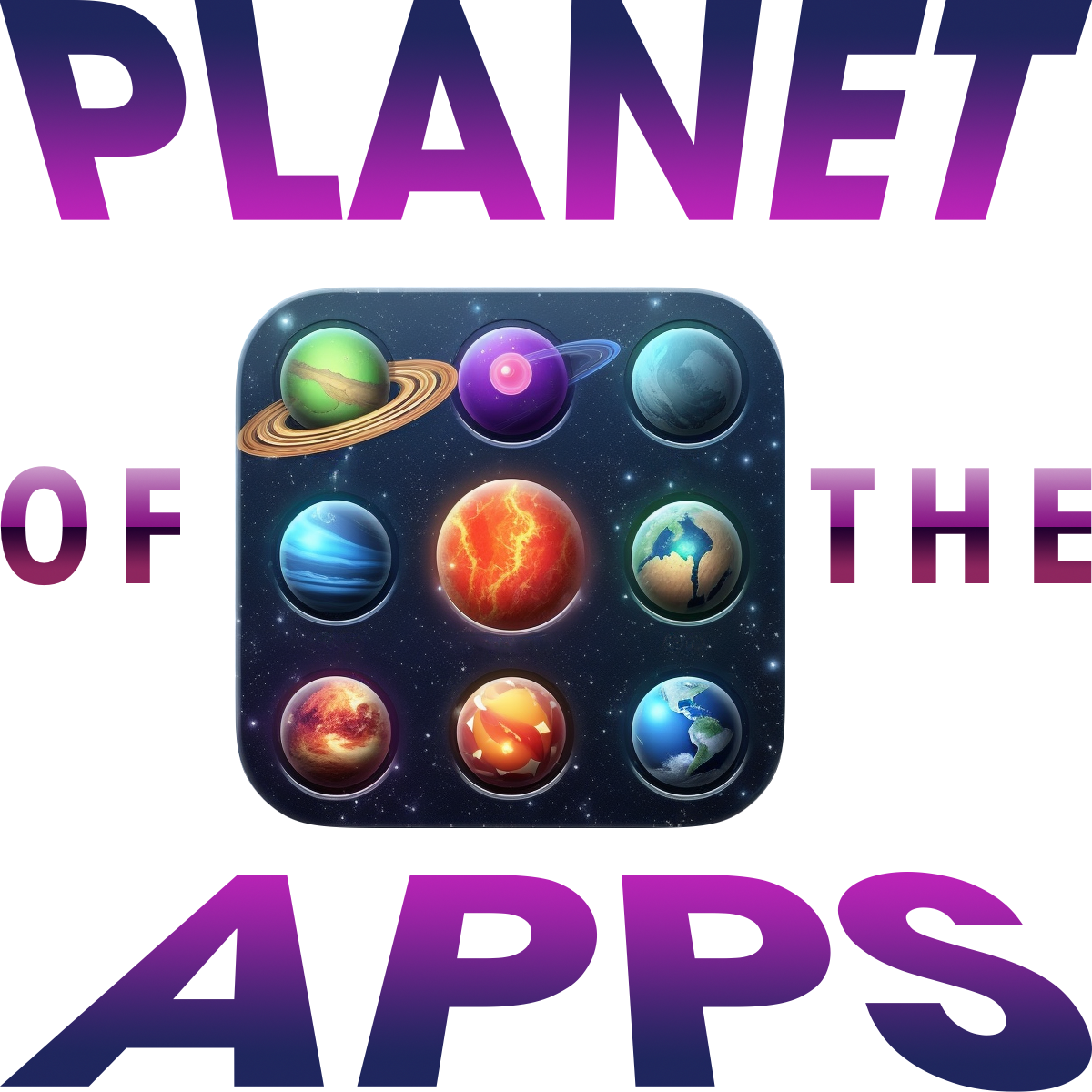 Planet of the Apps is a series of interviews with app developers about making, marketing and maintaining apps in the App Store.
Planet of the Apps is a series of interviews with app developers about making, marketing and maintaining apps in the App Store.
Indie developer and podcaster Casey Liss used to hate SwiftUI, Apple’s controversial UI toolkit for crafting apps. A lot of developers have a deep and abiding animus for SwiftUI, including Liss himself. But after using SwiftUI to create his latest app Callsheet, a movie and TV database app, he’s now a huge fan.
“So much of SwiftUI, I love,” he said in a wide-ranging and surprisingly-interesting interview. “I went from nothing to a fully functional app … in the span of a couple of weeks… It was stunningly fast.”
Indie app development with Casey Liss
Liss has cooked up a new app for looking up movies and TV shows called Callsheet. It conveniently shows you where they’re available to stream, and cleverly, lets you hide spoilers that sometimes show up in other apps.
In making Callsheet, Liss made some bold decisions, like going all-in on SwiftUI — Apple’s toolkit for building apps that’s divisive among developers. But as he reveals in the following interview, he had very good reasons for using it.
Our conversation covers a lot of questions that plague indie developers (and some unexpected rabbit holes): why he designed the app way he did, how he decided to price it, alternative app stores, developing with SwiftUI, cool features he’s proud of, his dog, cool features he can’t make, the Mac we wish Apple made, the Apple car, the advent of Wi-Fi and the weird foods we eat.
Click here to watch the interview on YouTube or read the transcript below.
Transcript
Cult of Mac: Since the dawn of time, humanity has been begging for an answer to two pressing questions: Who’s that person on the TV and where do I know them from?
Could a brand new app from Casey Liss remove these barriers and unlock the next stage of human knowledge?
I have him with me here today. Say hello.
Casey Liss: Hey, that’s a lot of pressure. I’m a little nervous now, but hopefully we will unlock some new knowledge of some sort today, one way or the other.
Cult of Mac: So, who the heck is Casey Liss?
Casey Liss: Who knows? Who is Casey Liss?
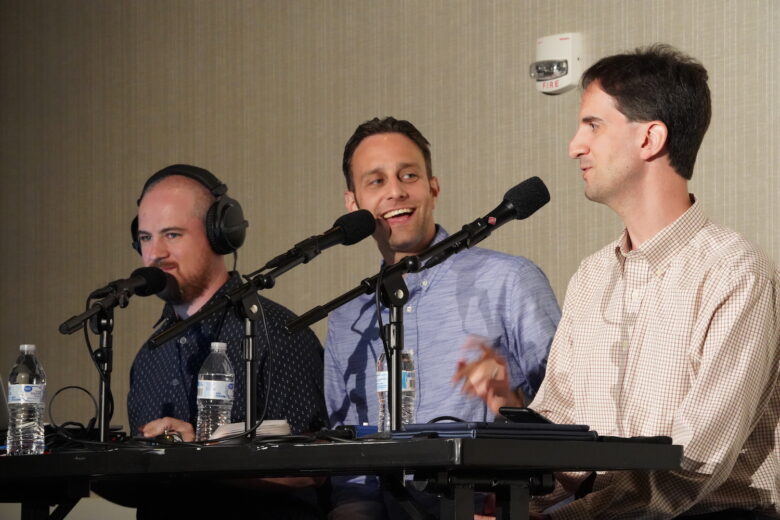
Photo: David Smith
So hey, I’m a podcaster, developer, and occasionally a writer based out of Richmond, Virginia in the United States.
If you know me at all, you probably know me from the Accidental Tech Podcast, which I do with my buddies, Marco Arment and John Siracusa.
I have a couple of other apps in the App Store that you may or may not have heard of.
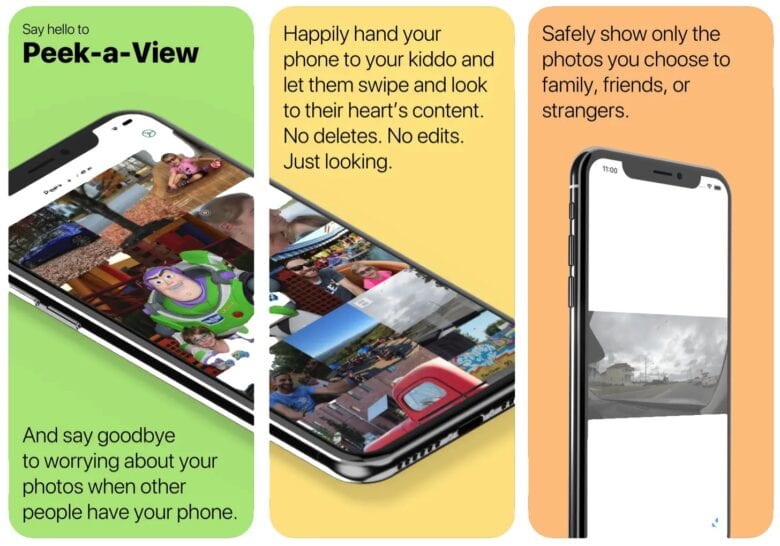
Image: Casey Liss
There’s Peek-A-View. It allows you to hand your phone to someone and they can flip through the pictures on your phone and they can only see certain pictures and they cannot delete them. There’s no way to delete them.
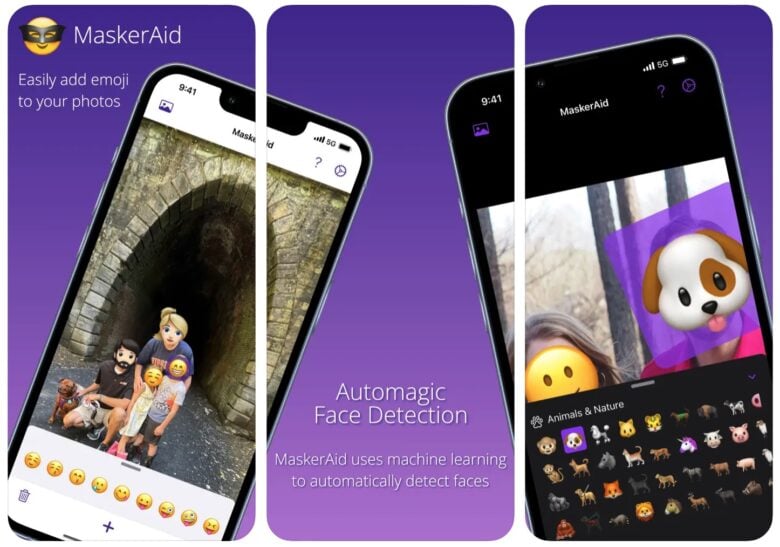
Image: Casey Liss
I also have another app called MaskerAid. The idea there is, hey, maybe you took a group shot with a bunch of friends, and maybe not all of them are friendly to social media, or maybe it’s children, and you don’t really want to blast these children’s images across the Internet.
What it does is it uses — well, I would have said machine learning, but now apparently I need to say AI — in order to detect where the faces are, and it’ll pop a little emoji on everyone’s faces, and it will do that automatically. It makes it really nice and quick and easy to share. But of course, you can customize which emoji’s which.
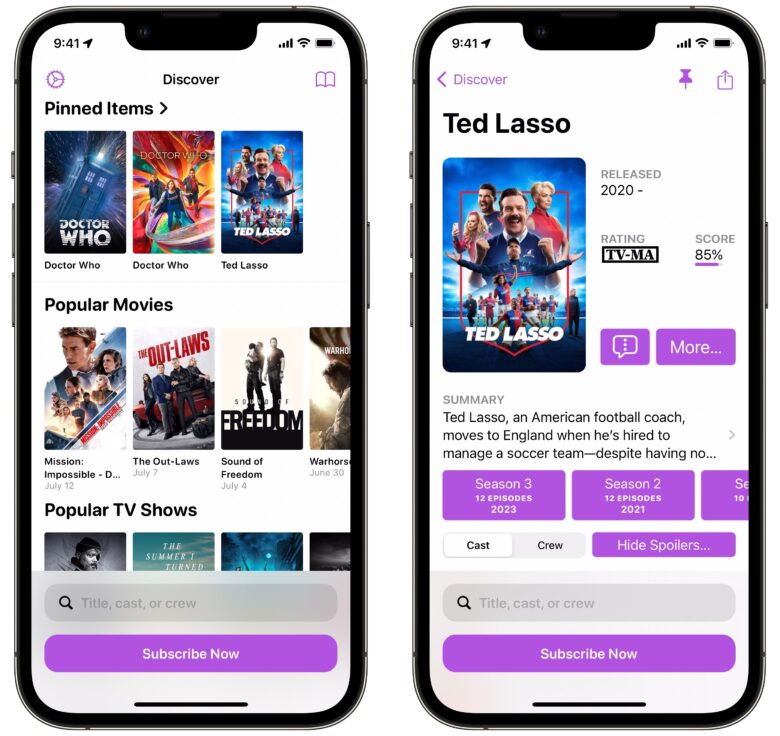
Screenshot: D. Griffin Jones/Cult of Mac
But Callsheet is basically, you know, where’s this actor from? When did this movie come out? What is the fifth episode in the third season of Ted Lasso?
It’s IMDB, but it doesn’t stink. And it’s not plastered with ads everywhere. It doesn’t want to autoplay videos. It’s just a nice version of IMDB by someone who actually gives a crap.
Cult of Mac: So what was your motivation for making this?
Casey Liss: Yeah, you know, I’m one of those people that annoys my wife dearly and deeply because, you know, I’ll be watching a show and it’s like the Leonardo DiCaprio, you know, “I know, I know them from… Oh, I got to look it up!”
And I’ll of course go to IMDB and I have the IMDB app on my phone, but the app is —well, I feel like it’s designed to infuriate me. It’s very, very frustrating. And I just got sick of it.
Some of the other software I use uses a couple of websites, The Movie Database and The TV Database. And both of those websites have fairly robust data sources for this sort of thing. And I started just kind of kicking around against the API, like, can I do something with this? And sure enough, it turned out I could.
And then, you know, over the years, I’ve gotten better and better at SwiftUI. One of the great things about SwiftUI is that it lets you do stuff very quickly, be that prototype or even develop an honest-to-goodness app. But it was not that long before I had the essence of Callsheet.
Hopefully, when you use Callsheet, it’ll become clear that I’m trying to sweat the details. And so I’m trying not to be self-serving. I’m trying not to put ads — I don’t have ads as we record this — I don’t have ads in your face. I’m not playing autoplaying videos.
I’m trying to make it one of my favorite kinds of apps, which is, figure out what you need to figure out and move on with your day. That’s the best case scenario.
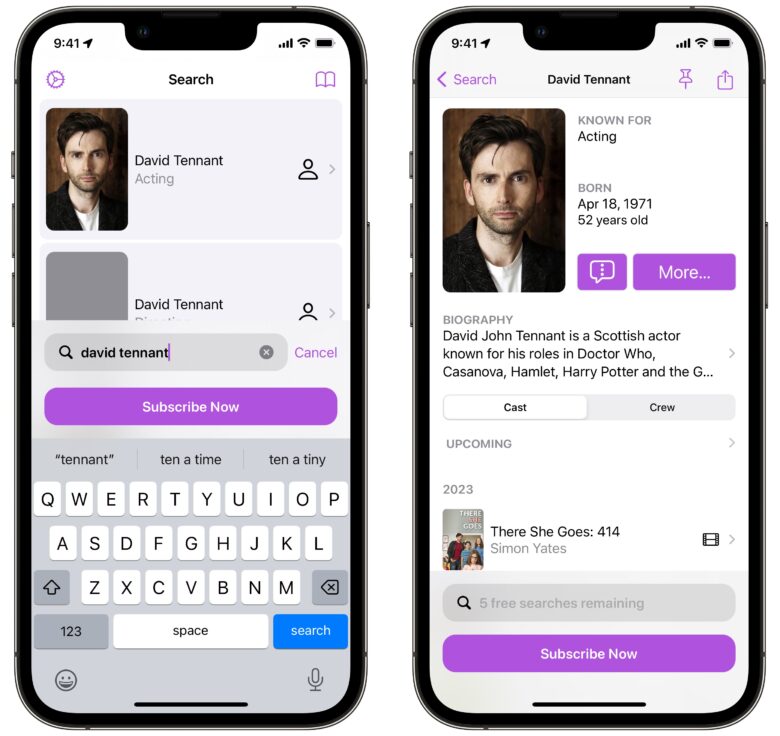
Screenshot: D. Griffin Jones/Cult of Mac
Cult of Mac: In designing a reference tool like this, you really have to optimize for speed and information density. So can you walk us through some of the decisions you made when you’re designing the user interface of your app?
Casey Liss: Yeah, it’s really tough because as with all apps, especially done by individuals, it’s a reflection of what the individual cares about. And I think that’s true, I guess that’s very true of IMDb as well, but it’s a reflection of what Amazon cares about, not necessarily the developers of the IMDb app.
Cult of Mac: It’s a reflection of what the various market forces that drive them to be profitable care about.
Casey Liss: Exactly, exactly.
And so for me, what I typically do on IMDb and now Callsheet is, I’ll look at who are the top four or five crew members and then the four or five cast members as well. But I also care about, like, when was it released? How long is it?
When I started putting this in front of more and more beta testers, though, that became a little bit squishy because the information that I care about may not be the information that you care about.
And where-to-watch is a great example of that. During the development process, I had thought, “oh, I’ll integrate with some sort of ‘where can I watch Ted Lasso?’ sort of provider at some point.” But I kept having people say to me, “You should really add where to watch. You should really, really add it. You should really add it.”
And they were right.
It’s that care that hopefully sets me apart from IMDB as an app that cares about what its users want and less about what the developers want.
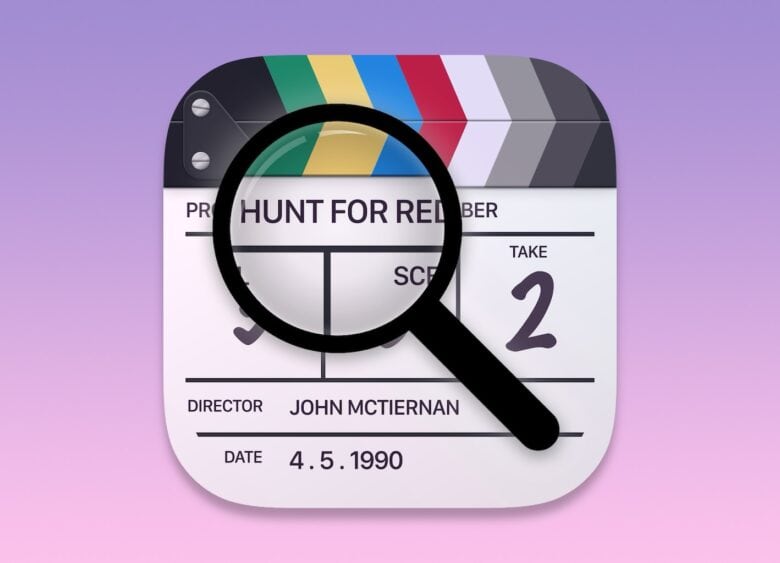
Image: Casey Liss
Cult of Mac: The app icon is of a movie clapperboard. What movie details do you put on there?
Casey Liss: Well, as we sit here now, the movie that’s shown is The Hunt for Red October by John McTiernan, which is one of my, if not my, favorite movie of all time. I’m a little nervous that’s potentially a copyright issue or something like that, because I don’t want to imply that like, you know, John McTiernan or the Hunt folks have endorsed the app, although they should.
So I might change the text on there, but my plan is if the text is changed, it’s going to be like, The Search for Blue March.
I couldn’t help but put an homage in to one of my favorite movies.
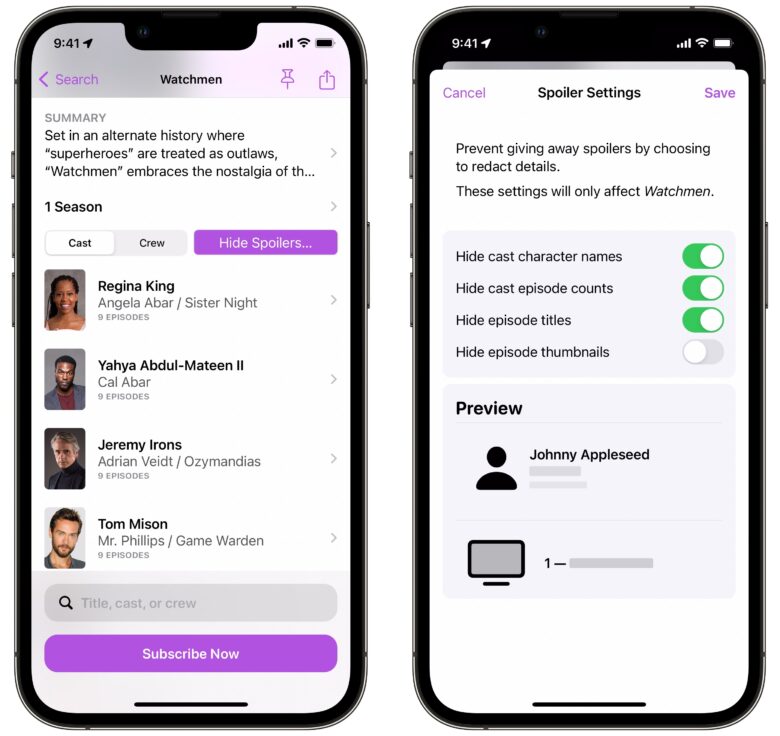
Screenshot: D. Griffin Jones/Cult of Mac
Cult of Mac: So below the surface level features of the app, you know, looking up actors and series, what are some of the cool advanced features that you want to mention for our audience here?
Casey Liss: One of the things I noticed is that when I’m looking at the cast of things in particular, oftentimes I’ll have something spoiled by it. And spoiler alert for Watchmen, one of the characters is the husband of the star in the show and they list his name — and forgive me I don’t remember his name there, but it was like John or Sam or something like that — slash Dr. Manhattan.
Whoa, whoa, that’s not cool. Like, I didn’t know that! They haven’t revealed that yet! I’m still mad about it two years later.
So as I was working on Callsheet it occurred to me — I can fix this problem. I have the power; that’s what’s great about being a developer.
And so what I’ve done, particularly for TV shows specifically, is I have an option for hiding spoilers and you can opt into doing this for a particular TV show. It’s shown above the fold, if you will, just above the cast and the crew, there’s a little button and then it brings you to a screen that says, “Okay, what would you like to hide?”
But the whole idea is: you should never ever be ruined. You should never have something spoiled just because you were interested in seeing who’s in it, because it is so infuriating when you’re just absolutely invested in a show like I was with Watchmen, and then all of a sudden this pivotal, critical moment has been ruined just because you were interested in who that actor was.
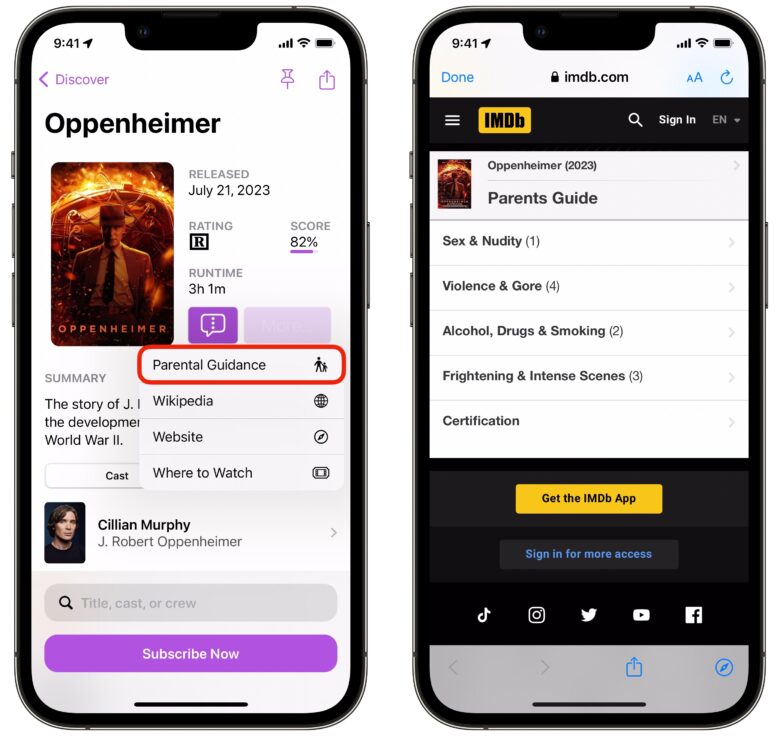
Screenshot: D. Griffin Jones/Cult of Mac
Cult of Mac: So what are the features you love to imagine, but are limited by today’s technology or impossible to develop as a one-man team?
Casey Liss: Some of the things that I’d like are difficult because they’re not affordable.
A lot of people asked for Common Sense Media, which is an organization that does really good parental guidance information for films and TV shows. I looked into integrating with Common Sense Media specifically, but they are one of those, “let’s get on a call and see if you can even afford it” kind of places.
And I suppose I could or maybe will see how prohibitively expensive that is, but it definitely does not strike me as the kind of thing where they want podunk single indie guy in Virginia to be integrating with their APIs.
And that’s too bad.
So what I’ve done is, again, fallen back on IMDB, and I’ll show you IMDB’s version of it in a web view.
That’s on the list of things that I think I might need to reevaluate once I get this thing out the door and hopefully get a little bit of traction behind it.
Cult of Mac: Choosing how to monetize an app is one of the hardest choices a developer has to make. How much functionality — at the time of recording — are you currently giving for free, and how are you charging for the full features?
Casey Liss: So this is extremely tough. My other two apps are free to try and then a one-time, hypothetically forever, unlock.
That didn’t seem appropriate for Callsheet because I don’t know what my costs will be from The Movie Database going forward. Although The Movie Database’s cost is minimal right now, I really don’t want to put myself or my users in a position where I have to say, “Oh, you know how it was super cheap before? Yeah, it’s going to be three times that now.”
And that’s a tough thing to balance, right? Because I know that everyone has subscription fatigue. I have subscription fatigue.
I am guilty of not even blinking an eye at spending $2.50 on a Diet Coke at a restaurant and thinking nothing of it. But if I see a $2.50 monthly subscription, I’m like, “Whoa, whoa.”
But for something that has an ongoing cost and including the maintenance of the app in general, I don’t think it’s unreasonable to ask for a little bit of money.
What I’ve landed on is, as we record today, is you’re going to get some amount of searches for free. I think that number will be 20, but I’m reserving the right to change it and tweak it. And then at that point, you’re going to have to subscribe to the app and you’re going to have to pay for it.
Hopefully, there’s enough padding for me that even if my costs go up some, I don’t immediately have to pass that down to my users. I can just eat that cost.
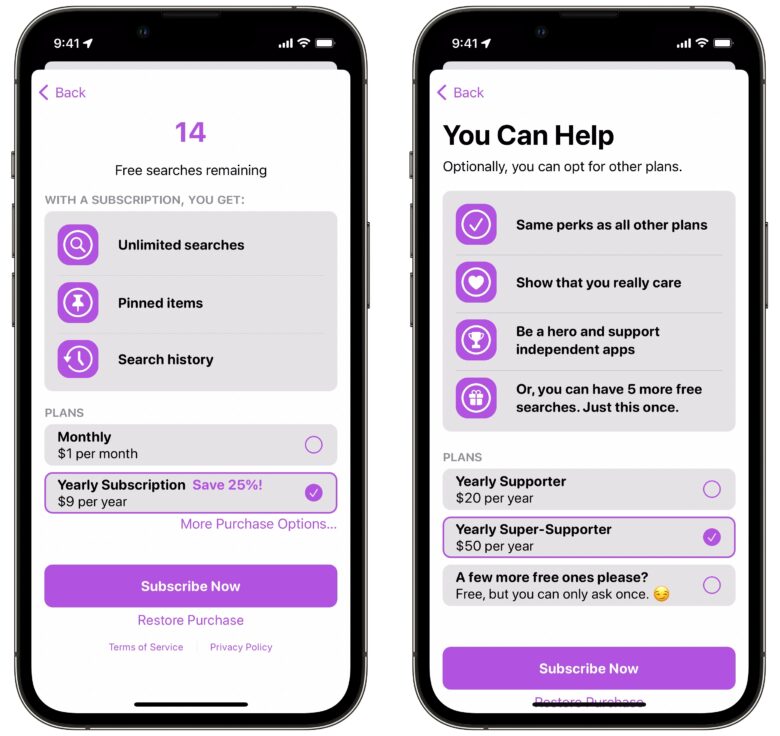
Screenshot: D. Griffin Jones/Cult of Mac
But I will say that I’m trying a couple of off-the-wall things. If you’re presented with what I call the pre-sale screen — basically the, “Okay, here’s where you would subscribe” — by default, there’s a monthly option and a yearly option. And then below that, at the bottom right, below the two options, there’s a text that says more options.
And if you tap into there, there’s a yearly version that’s basically twice the cost. And I’ll explain in a second. And there’s a yearly version that’s like five times the cost.
And those are effectively glorified tip jars. I don’t know if anyone will ever take me up on it, but you know what, if someone is hurting to give me a little extra money, who am I to stop them? So that gives you no perks other than my undying love, and it throws a little bit of extra money my way.
But the third thing: during the time you’re using your 20 free searches, if you tap all the way through into more options, and at least glance at the fact that I’m asking for yet more money, then at the bottom, at one time, you can say, “Can I maybe have like five more freebies, please?” And I’ll give you five more.
So that’s a whole bunch of words to say, I get it. Subscriptions are no fun. They’re not fun for me. Like if I thought I could get away with a one-time purchase and keep the business sustainable, I’d absolutely do that by keeping it simple and basically saying, do you want monthly or yearly, and quietly, do you want to just give me extra money because you’re nice? You know, do you want monthly or yearly?
Early on, the [paywall] that you’ve seen most recently had like a couple of bullets and then a picture of our dog at the bottom. And I captioned it, “Penny, our dog, says thank you. Arf!” And I thought that was very cute, but the feedback I got was that was maybe not as professional as I wanted. So I pulled that.
Cult of Mac: Well, if you’re cutting the bit about your dog from the app, do you have a few words you would like to speak about Penny in this environment?

Photo: Casey Liss
Casey Liss: Yeah, so at the end of 2020, as with everyone else, we adopted a rescue. This particular dog, who again is Penny — backstory, my surname is Liss. You can’t really name your child Penny Liss, but you can name a dog Penny Liss.
She’s a Shar Pei, which means she was super wrinkly when she was little, and I like to joke that she’s been ironed out from the neck down as she’s grown.

Photo: Casey Liss
We had said to our dear friend who rescues dogs, you know, we would like not-a-puppy who is somewhere to the order of like 10 to 15 pounds and doesn’t shed. We ended up with a puppy who has grown to 35 pounds and sheds like hell, but you can’t win ’em all.
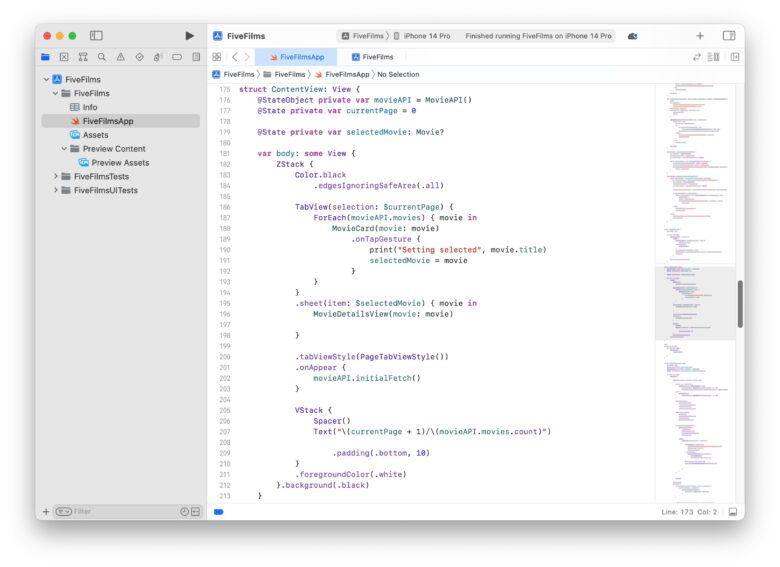
Screenshot: D. Griffin Jones/Cult of Mac
Cult of Mac: Regarding SwiftUI, you touched on this earlier. It’s sort of a controversial new user interface framework amongst developers. I have just a few quotes here. Ethan Lipnik said in an interview with me, “I couldn’t deliver a good product if it was 100% SwiftUI.” Shihab Mehboob, developer of Aviary and now Mammoth, said “It’s too unreliable at the moment to use in a fully-fledged feature-rich app,” and he “wouldn’t dream of building an entire app that relies on it.” And, this, uh, ‘Casey Liss’ said…
Casey Liss: Oh, that guy, he has no idea what he’s talking about.
Cult of Mac: “A lot of it, you just can’t freaking do. And the tough thing is, it is a black box. Once you hit the wall or the edge of that black box, you’re screwed.”
Casey Liss: Who would have said such a thing? No way, no way. Oh, man. You know, SwiftUI, it’s a very interesting, very, very interesting beast. I have come to quite like it. I would say 99% of Callsheet is SwiftUI.
It’s funny because when I first started developing Callsheet, which was just a couple of months ago, I ran into an issue where as you scrolled and things fell off the screen, they would just never come back. So if you scroll down the screen and then come back up the screen, the stuff at the top, it would just never, ever come back.
But there was a point release coming for iOS 16. And I was like, “Well, I know I’m not ready to release yet. Maybe it’ll get fixed,” and sure enough, it got fixed.
It used to be in the original versions of iOS, you would have the title tiny, up at the top of the screen, and then over time — I think was iOS 7 or something like that — they put they would put the big title where it would say Inbox and then you would have your inbox below it, but if it’s more than one line you just get an ellipsis.
So it’d be, The Hunt Fo…
No, I’d like multiple lines please.
No no no, you get, The Hunt Fo…
No no, but that doesn’t work for me, I need both the lines.
Well, I’m sorry, you get The Hunt Fo… and you will like it. And stuff like that.
So much is so easy in SwiftUI. Adding the search box is preposterously easy. You just say .searchable() please, and say where you would like the text stored.
That’s it. It’s amazing.
But the flip side to that is occasionally you run into these walls, like the title, where there’s nothing you can do. And I didn’t have to go down to UIKit to fix it, but I had to do way too much work.
And so that’s something that’s silly, but also kind of a show stopper. Like if this wasn’t fixed already, I genuinely may not release the app or would have to like completely re-architect the app. So it works very, very differently just to get avoid this very unusual gotcha.
But so much of SwiftUI, I love.
I am not a good designer. Doing something like rounding the edge, like putting a corner radius on an image or a rectangle in UIKit — which is the prior, old-school version of iOS user interface programming — it seems like more work than it should be, just to round the edge of something.
Whereas in SwiftUI, you just say .cornerRadius() and you tell it how much of a corner radius you want.
I went from nothing to a fully functional app — it was kind of a garbage app, but it worked — in the span of a couple of weeks maybe, it may have even been less than that. It was stunningly fast.
Whereas if I was working on this in UIKit, it is just so much slower and there’s so much more code involved. I would rather not ever have to write UIKit again if I can avoid it.
All that being said, the quotes that you had earlier, including from that dope Casey Liss, I could passionately agree with any one of them. I could make an argument that even today that it’s too soon for SwiftUI.
Obviously that’s not what I believe, but I can make the argument.
Cult of Mac: So despite all of those qualms, do you think you’ll be using this going forward and maybe switching your other apps into SwiftUI?
Casey Liss: MaskerAid was almost entirely SwiftUI. Peek-A-View was mostly UIKit with a little bit of SwiftUI sprinkled in.
The problem with those apps, like, I still maintain them. They’re still out there. I plan to maintain them, but for better and for worse, they don’t make that much money.
And I think some of that is because they’re just not as appealing as I hoped they would be. But some of that is because you pay once and that’s that. And so if you think about it from my perspective, I’m not terribly incentivized to work on those apps.
There’s a lot that I have yet to do in Callsheet, whereas with the other apps, I think there are some things that I could add to them, but they are mostly fully realized at this point.
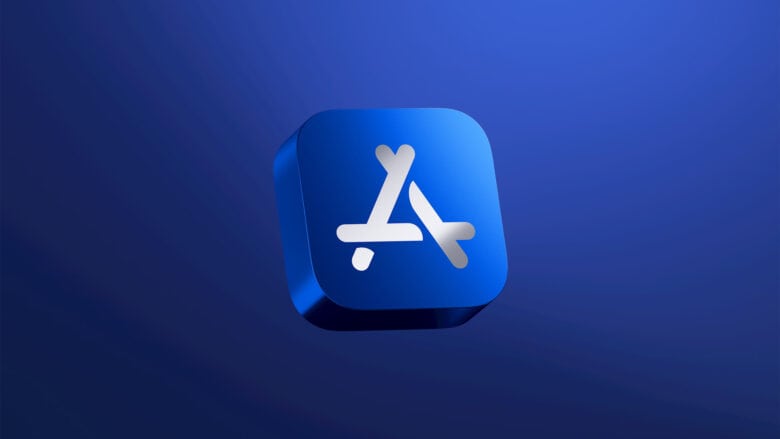
Photo: Apple
Cult of Mac: So would you ever consider distributing your app on an alternative app store if Apple were ever made to implement that sort of thing?
Casey Liss: I would consider it for sure. I think it would be ignorant of me to say that I wouldn’t even think about it.
I think it would take a lot for me to do it though, because the App Store is going to be the default forever. And I think it makes sense for that to be the case. I would be very surprised if any other app store had any real traction.
And so even if it’s a more lucrative proposition for me in terms of the fees that I pay, I’d be surprised if it would end up lucrative on account of the fact that now there’s an additional barrier to entry just to get my foot in the door.
Cult of Mac: Did you see, just before we started this meeting, that Apple put out a press release that “developers generated 1.1 trillion […] in the App Store ecosystem in 2022.”
Casey Liss: Uh-huh. Yeah. Yeah. I’m sure they did. Now I’m sure you didn’t enjoy taking your 15 to 30% of every one of those transactions, it’s services, services, services.
Cult of Mac: [sarcastically] How else would they pay for it?
Casey Liss: I really do enjoy Apple and I know a fair number — and I’m sure you do as well — a fair number of rank and file engineers. And particularly the rank and file really do just want to make cool stuff that makes people happy.
The one thing I will say though in conflict with myself is that, especially for the rank and file that have been there a long time, there’s a alarming amount of — and I don’t want to say the word entitlement, but I’m going to use it because I can’t think of a better one — but entitlement that “Look, we Apple have put in all this work. You wouldn’t have a Callsheet if it wasn’t for our iPhone. So yeah, you owe us.”
That’s completely fair. And early on, yeah, that made sense. Like 2007, 2008, 2009, you’ve earned it. You did something that is truly remarkable. And I think you should be compensated for it, but that was iPhone 1.
It’s not the same place it was in 2007. This is not the same market. This is not the same universe.
And it would be healthy for Apple to realize that yes, I wouldn’t have Callsheet without the iPhone, but we wouldn’t have the iPhone without people like me.
But that being said, everything about an alternative app store feels even worse. So I still come back to “please, sir, can I have another?”
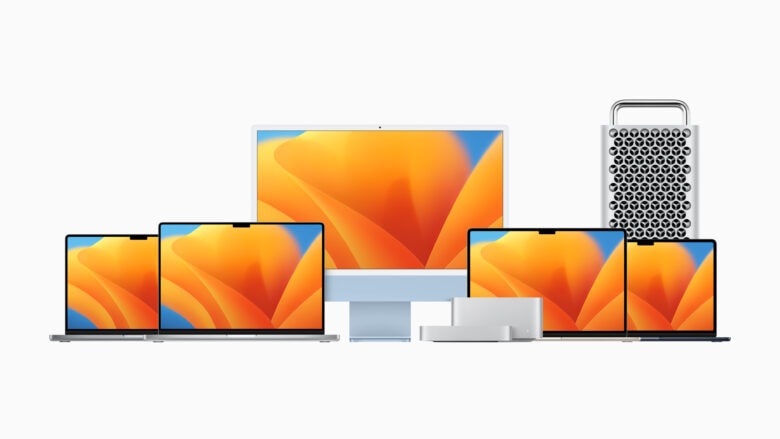
Photo: Apple
Cult of Mac: Now in our beautiful Apple Silicon world, they’re once again expanding the Mac lineup, which I don’t think anybody would have expected 10 years ago. What is the dream Mac you wish Apple would make just for you?
Casey Liss: This is going to be a mostly boring answer. My current computer, which is a an M1 Max 14-inch MacBook Pro. It’s really good. Like it’s really good.
The only thing I can really think of that I really wish this computer had is a cellular modem. I would give my arm for a MacBook Pro with a cellular modem.
And I know that to so many people, that sounds bananas. When I’ve made the same speech about iPads, so many people will be like, “Why would you ever pay for cellular iPad? That’s bananas. Just tether. It works fine.”
That’s not really wrong. To be honest, that is correct. But it is so much more delightful to just open the device and immediately you’re connected to the internet. It’s magic.
You don’t have to worry about connecting via Wi-Fi or a cable. You don’t have to worry about whether or not the Bluetooth communication that gets the devices to know that they’re near one another to, you know, do the magic auto tethering. You don’t have to worry about that. You’re not killing two batteries. You’re only killing one battery.
Like in so many ways, I prefer to have my devices have their own internet connections.
And my word — as someone who is disproportionately pleased by working in odd locations, like parks and train stations and things like that, it would make me unreasonably happy.
If I could give Apple another $150 on top of the like 5,000 or whatever obscene amounts I spent on this laptop was, in order to get a cellular modem, and as much as it would destroy me to give Verizon another $10 or $15 a month to enable said cellular modem, I would do it.
I would not even think about it.
Cult of Mac: I have absolutely no need for this and no desire for it, but I think it would be neat if they went the opposite direction as well and competed with like those ludicrous “gaming” laptops. They bring back it in the 17-inch MacBook Pro form factor. They give it an insane battery. They put the Ultra in it, because the Ultra is exclusive to the Mac Studio. And to put the icing on the cake, they anodize the whole thing with black, like the keyboard.
Casey Liss: Well, don’t even tease me about that. So my first Mac was a polycarbonate MacBook. And this was when you could spend another $150 to get a black polycarbonate MacBook. And I was so jealous of anyone — I was too cheap to do it myself. I couldn’t bring myself to do it.
I was so jealous of anyone with a black MacBook. I thought they were the coolest.
I don’t think I have a desire for a large laptop like that. But where you would get me interested is if you said “It’s so big that we can fit an ethernet port in there,” because I am one of those lunatics that still uses ethernet religiously. I try to use ethernet wherever possible because it is so much nicer, so much faster.
If there was any way to find a MacBook that was so big in general, that putting ethernet on board kind of made sense, I would be so there for that. I would really think about it. Because I have no desire for 17 inches, but if you said 17 inches with an ethernet jack, maybe!
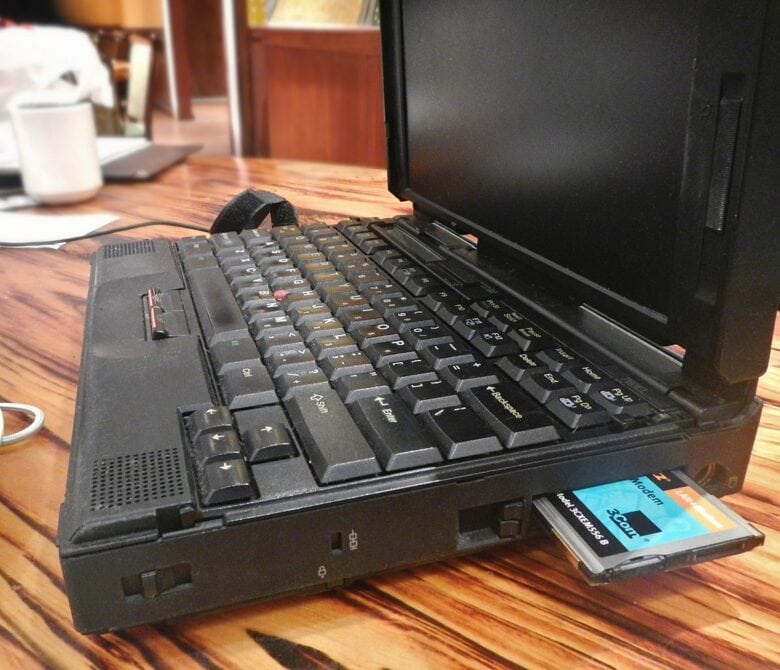
Photo: Jim.henderson/Wikimedia Commons
In the early aughts, you would do the little thing where you would like, slot load or you would —
Cult of Mac: Yeah, you could get an ethernet jack inside of a PCMCIA card slot and you put it in vertically.
Casey Liss: That’s exactly — we’re saying the same exact thing. Yep. Yep. Yep.
When I was in college, it was 2003 or ’04. And I remember I thought I was hot stuff because I had a ThinkPad where you could flip it upside down — I loved ThinkPads — you’d flip it upside down and you could unscrew a door and you could slot in a Cisco wireless card in it. In the display, they had the antennas, they just weren’t hooked up to anything.
And so you could have an onboard wireless card rather than the PCMCIA wart sticking out the side of the computer. I had a few of those Cisco cards as well.
And oh man, when it was internal, I was hot stuff. Let me tell you, I thought I was so cool running around Virginia Tech, not having to have one of those stupid little dongle — or, not dongles — bulges sitting out the side of your computer.
Ah, those were the days.
Cult of Mac: What are some of your other least favorite websites?
Casey Liss: Anything that requires a two-factor code through SMS. I kind of die a little inside anytime that happens, including my bank.
The Amazon app on the iPhone is garbage, which sounds a little bit like IMDB. Who, coincidentally, as we’ve mentioned, is owned by Amazon. That app I don’t care for at all.
And what’s frustrating is now that we have a dog, as we discussed, we’ve been using Chewy from time to time. The Chewy app is either native or such an unbelievably and impossibly good web view that I cannot believe they made it this good.
And using the Chewy app has just snapped into focus for me how awful the Amazon app is, and how frustrating and slow it is. And so, yeah, that’s not a website, but that’s a great example of something that’s just infuriating.
Cult of Mac: For any public persona on the Internet, it’s a rite of passage when you start experiencing a catastrophic bug that you desperately want Apple to fix. What are the bugs that are currently affecting you?
Casey Liss: I don’t have any that I can think of right this minute, but I will say it was an iOS release or two ago, so it was like 12, 13, maybe 14. My family is all in on iPhones, but my wife’s family is all in on Android — possibly just to spite me at this point, but whatever, I respect the game.
We would just not receive messages. And so we would have to like take our phones and like sit there and like compare. All right. Who got what message? What? And we’re like trying to like Sherlock Holmes our way into figuring out what the entirety of the conversation was.
And this went on for months. And I was just ripping my hair out trying to figure it out and there’s nothing I can do about it.
And of course, I’m like, I’m throwing stuff across the wall in Feedbacks, I’m taking SysDiagnoses like it’s my job and I would collect these logs and I would wait for it to happen.
And you know, again, I’m like, doing this with Erin’s phone and my phone. I’m like, “Oh, what happened, what happened?” And I forget what the incantation trying to make sure I grab the SysDiagnose when it happened so I can give it to the engineer so they have something to work with, and all of a sudden, it just magically went away.
And I wish I could tell you that was because of me but I think it’s just somebody realized it was something wrong somewhere in the stack and it got fixed but it was infuriating.
And let me tell you if you really really love your spouse — which I hope you do, and I very much do — there is nothing more painful than your beloved spouse saying to you, “Why won’t my piece of garbage phone work,” especially when you make your living talking about that piece of garbage. So it was a rough time around the Liss household for a few months there and that was brutal.
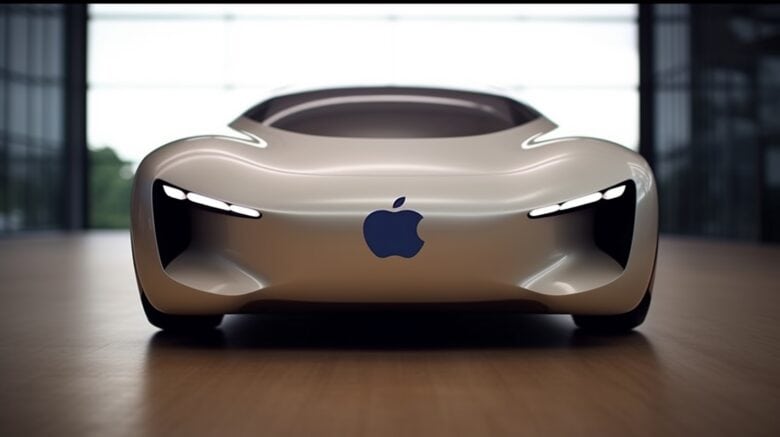
AI image: Midjourney/Cult of Mac
Cult of Mac: So you’re a car enthusiast as well as a tech enthusiast. And at the intersection of that is the rumored Apple car that was apparently so embarrassingly expensive that the project was scrapped and rebooted from scratch. So my question is — what weird luxury car features do you imagine that concept Apple car might have had?
Casey Liss: Probably a cellular freaking radio, I bet it had one of those.
It’s hard for me to envision it, but I think there’s something very powerful about the idea of the device that is most central to your entire life, which is your phone, imagine that having really honest-to-goodness, you know, from the core, integration with the device that, especially if you’re American, especially if you live in the suburbs like we do, the device that is your gateway to the world.
Like your phone controls your whole world, but your car is how you get there. And I can imagine that there could be some really impressive stuff.
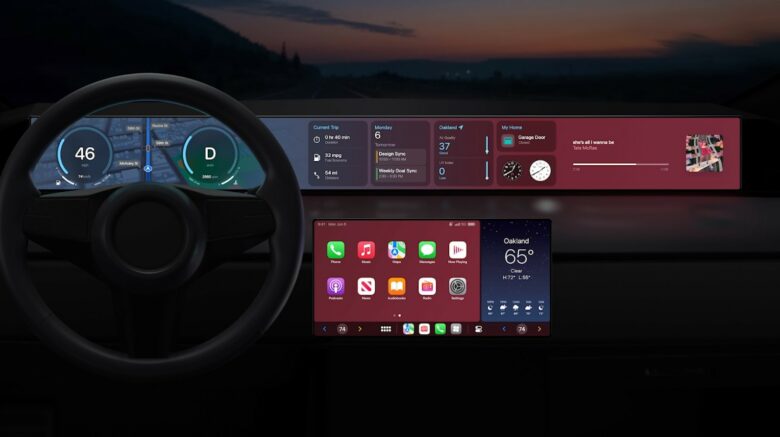
Photo: Apple
If you could really and truly integrate the two of those, being able to route plan on your phone or your iPad or even your computer and have that seamlessly beamed or carried over to your car. I think that’d be neat. I think if Apple were to integrate with charging infrastructure, I could see them doing a more robust job of understanding what’s available, when it’s available.
I’m sure a lot of this exists in some way, shape, or form, but the thought of having it all integrated and consistent across the board is very appealing to me.
If Apple silicon is showing us anything, being deeply overpowered can be fun. As a car enthusiast, having way too much power is always a good thing. So I could see, you know, an Apple car being just stupidly, stupidly fast, like some Teslas are. And that could be fun too.
Cult of Mac: I drive a Prius, so I wouldn’t know anything about that.
Casey Liss: Hey, the new Prius looks really good, actually, I have to say.
Cult of Mac: It does look really nice.
What is the fast-and-sad meal you make yourself when you (A) need to get a quick meal, but for whatever reason, you can’t eat out and you need to make something yourself; (B) you’re feeling a bit down and (C) you’re completely alone with nobody to judge you.
Casey Liss: The obvious answer, which is an honest answer is a Velveeta Shells & Cheese. I do love Velveeta Shells & Cheese.
If you’re not American, it’s going to look truly terrible, but basically it’s pasta — I forget the name of the pasta, but it’s shell pasta — and then it comes with a packet that appears to be a packet of like foil. I’m not sure that’s actually accurate, but it looks like foil.
And there’s like this gelatinous-like goop cheese in there. And so you boil the pasta just like you normally would. And then you squeeze the cheese, squeeze it out of that thing into the pot and mix it up.
I know it sounds disgusting and I’m not doing a very good job of selling it, but it is so good.
We really like cheesy rice, which is you cook up the rice and vermicelli, and then you put like this cheese dust on top and you stir it in and it becomes this like cheesy rice. And again, like, I’m sure any reasonable human with self-respect would find either of these completely revolting, but, uh, I enjoy both of them deeply.
What’s yours?
Cult of Mac: Way to turn it around on me. I know that a lot of people who don’t know me are going to watch this. So I’m not going to admit to the most heinous one.
Casey Liss: Oh, come on. Where’s the fun in that?
Cult of Mac: I haven’t done this since college. You get like a six-pack of the Johnsonville precooked sausages or something.
Casey Liss: Which is delicious. It’s a heart attack, but it’s delicious.
Cult of Mac: You buy two six-packs of that and a single 12-pack of hot dog buns so that you can wrap it up all in a period of two weeks or so.
Casey Liss: That’s amazing. I am not above this. It actually sounds very tasty.
Cult of Mac: It’s four meals of three of those each.
Casey Liss: [audibly winces] That is, um, I think I might need to go see a cardiologist after just hearing that described, but it does sound delicious.
Cult of Mac: We’re not at the bottom of the hill yet.
Casey Liss: All right, tell me more.
Cult of Mac: Because eating the same thing three times might get repetitive, I have a specific array of sauces.
Casey Liss: Excellent.
Cult of Mac: First one ketchup and mustard.
Casey Liss: Okay.
Cult of Mac: The second one mustard and barbecue sauce. The third one barbecue sauce and ranch dressing.
Casey Liss: So this is preposterous, but I’m here for it.
There’s a drive-in theater that’s half an hour west of Richmond. It’s in between Richmond and Charlottesville and it’s called the Goochland Drive-in Theater. Goochland is the name of the county in which it’s placed at the Goochland Drive-in Theater.

Photo: Casey Liss
They have something called the Gooch Dog, which is a hot dog, but then they put macaroni and cheese on top and then they put barbecue sauce on top of that. And it’s one of those things where this doesn’t sound very good, but oh, my word, it is terrible in the most delightful ways.
I would eat that right now if it was put in front of me. I wish I was on one of those food shows where they have the like thing come in from off screen, you know, and they just hand it to you and you get to chow on it. I would do it right now.
Cult of Mac: Hot dogs already, I think, have a marketing problem.
Casey Liss: But that’s true. That’s true.
Cult of Mac: Calling it a Gooch Dog…
Casey Liss: It’s not good.
Cult of Mac: …I don’t see how they think that helps.
That’s all my questions. You can download Callsheet from the App Store.
Casey Liss: Well, thank you so much for spending all the time with me. I really do appreciate it.
And yeah, I hope you check out Callsheet. Again, you get a little bit of time with it for free. It can’t hurt. Give it a whirl. Kick the tires. See what you think.
And send me an email if you have an idea about it. Or if you don’t like it, tell me why you don’t like it. Give me something actionable to fix, and maybe I’ll be able to fix it.
- Callsheet: App Store
- Accidental Tech Podcast: Apple Podcasts, Overcast
- Analog(ue): Apple Podcasts, Overcast
The video and transcript have been edited for grammar and length.
![Indie dev Casey Liss on how he came to love SwiftUI [Planet of the Apps] Casey Liss and Callsheet](https://www.cultofmac.com/wp-content/uploads/2023/07/Casey-Liss-and-Callsheet-1536x864.jpg)

